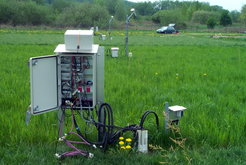Deciphering nature's climate shield: Plant diversity stabilises soil temperature
A new study has revealed a natural solution to mitigate the effects of climate change, such as extreme weather events. Researchers from Leipzig University, the Friedrich Schiller University Jena, the German Centre for Integrative Biodiversity Research Halle-Jena-Leipzig (iDiv), the Max Planck Institute for Biogeochmeistry in Jena, and other research institutions have discovered that high plant diversity acts as a buffer against fluctuations in soil temperature. This buffer can then be of vital importance to ecosystem processes. They have just published their new findings in the journal Nature Geoscience.
“Soil temperature plays a central role in controlling important ecosystem processes related to water, carbon and nutrient dynamics, microbial activity and agricultural productivity,” explains the lead author of the study, Dr Yuanyuan Huang. Despite its importance, no study has yet investigated whether plant diversity in particular acts as a buffer against fluctuations in soil temperature during long-term plant community development.

In their study, Huang and her colleagues present the results of a comprehensive data set collected from 2004 to 2021 in a large-scale grassland biodiversity experiment – the Jena Experiment. The experimental site consists of 80 plots with a variety of plants ranging from one to 60 species. In addition, four plots of unplanted soil and two plots of uncontrolled vegetation provided important reference points. Soil temperature was automatically recorded at depths of five and 15 centimetres at one-minute intervals over a period of 18 years, which spanned considerable climate variability. Dr Anne Ebeling, scientific coordinator of the experiment, says: “We have just celebrated the 20th anniversary of the Jena Experiment. Over these two decades, we have experienced a number of extreme weather events, including prolonged droughts, a major flood in 2013 and exceptionally cold springs.” Gideon Stein, the second author of the study and responsible for the data preparation, adds: “It is really interesting to see how many historical events can be found in the temperature data of the Jena Experiment.”
“This unprecedented analysis of long-term, high-resolution data provides compelling evidence that plant diversity acts as a natural buffer and provides stability in the face of climate extremes,” emphasises Huang. Throughout the 18-year period, plant diversity showed a remarkable ability to protect the soil from overheating in scorching heat and to help retain heat in colder periods.
In summer, on days with particularly high air temperatures, the soil temperature in plant communities with 60 species was 5.04 degrees Celsius lower than in plots with no plants. For comparison, this difference is more than double the difference between monocultures and bare soil at the same time. However, on days with particularly low air temperatures, the soil temperature in the 60-species plant community was 1.48 degrees Celsius warmer than in the plots with no plants, which in this case is almost five times the difference between monocultures and the bare soil.
The researchers concluded that plant diversity can stabilise soil temperature throughout the year. The effects intensified as the experimental communities became older, and are even more pronounced under the harshest climate conditions, such as scorching hot days and dry years.

In a second step, the scientists set out to investigate the causes of the stabilising effect of plant diversity. Plant diversity not only increased the total leaf area of the plants, leading to greater shading, but also increased the organic carbon content of the soil. "We were surprised at how much soil organic carbon influences the stability of soil temperature. It even exceeded the importance of shading," explains Markus Lange, co-author from the MPI for Biogeochemistry.The stabilising effect of plant diversity was demonstrated by a reduction in heat conduction in the top 60 centimetres of soil. As a result, soil temperature remained more stable throughout the year and throughout the topsoil in communities with higher plant diversity.
These findings have far-reaching implications. In temperate grasslands and beyond, the stabilisation of soil temperature provided by plant diversity could be crucial in mitigating the negative effects of extreme climate events. This includes the decomposition of carbon in the soil and its release into the atmosphere. According to the researchers, this natural mechanism thus also has the potential to slow down the process of global warming.
“Our research shows the remarkable ability of plant diversity to act as a protective shield against the impacts of climate change. It is a stark reminder of the importance of conserving and promoting biodiversity in our ecosystems to protect the environment and ensure a sustainable future,” says Professor Nico Eisenhauer, head of the study and spokesperson for the Jena experiment. He adds that the study not only adds to our understanding of the vital role of biodiversity, but also offers a glimmer of hope in the ongoing fight against climate change.
This press release was kindly made available to us by the University Leipzig.













